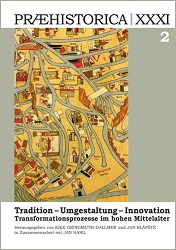Die Kirche ins Dorf bringen. Über den Bau von Dorfkirchen im Rahmen der Ostsiedlung zwischen Elbe und Oder
Bringing the Church into the Village. On the Building of Village Churches in the Line of Ostsiedlung between the Rivers of Elbe and Oder
Author(s): Ulrich WaackSubject(s): Architecture, History of Church(es), Social history, Middle Ages, Social development
Published by: Univerzita Karlova v Praze, Nakladatelství Karolinum
Keywords: Northeastern Germany; Middle Ages; settlement activity; village churches; church building; building materials; finances (of church building);
Summary/Abstract: Referring to the topics of Christianization and building of churches in the Germania Slavica, there are a lot of prejudices and misjudgements, which need to be clarified. The so-called “barbarian” pagans between the rivers of Elbe and Oder possessed temples whose virtuosity was praised by the contemporary chroniclers. Not least inspired by the example of their Slavic neighbours in Bohemia, Poland and Russia, which had converted to Christianity at the turn to the second millennium, the Wend chieftains showed a willingness to assure the access to the West European cultural area by a process of acculturation. To the east of the Roman cultural border – defined by the Rhine and Danube rivers – cement jointed stone structures were unknown to Germans and Slavs alike before the introduction of Christianity. Therefore the earliest churches arose as timber structures. Even following widespread implementation of the technique of stone structures, the churches in newly founded villages were initially constructed in timber for reasons of cost. The building material of fieldstone was not available without difficulty, being found only in clay soil. In the old settlement areas, construction with fieldstone was known only sporadically, in coastal regions. For that reason the building of village churches exclusively in fieldstone developed primarily among the conditions of late medieval land consolidation (“hochmittelalterlicher Landesausbau”), as well as the implementation of brick buildings. In addition, it was not until the eastward development of settlements that a parish structure evolved and with it, the pretension of each village to have its own church. Nevertheless the building of stone churches was in no way self-evident. For example, in the region of Barnim one third of the villages during the Middle Ages only had churches of timber or of timber frame construction, because there is a significant, verifiable correlation between the revenues from crop yields (caused by the largeness of bounds and the quality of soil) and the costliness of village churches. The building of the typical steeples, cross oblong and broad as the nave, nearly doubled the costs of construction. The desire for these steeples was not only a question of prestigious symbolism of power or the glorification of God, but needed a sufficiently good economic basis, too. By that reason it normally took at least a generation before a surplus of corn production made the building of stone churches possible. Thus the creation of robust fieldstone churches was neither area-wide nor represented a governed program of military buildings (fortified churches to secure some kind of continuous advancing “Eastern front”). The involvement of Cistercians in the building of village churches is also overestimated.
Journal: Praehistorica
- Issue Year: 31/2013
- Issue No: 2
- Page Range: 339-356
- Page Count: 18
- Language: German

